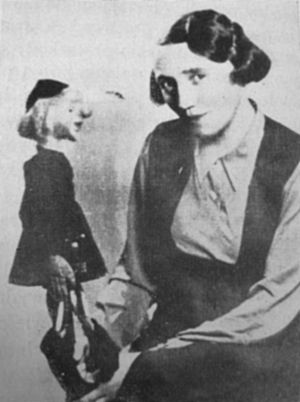Maria Kownacka facts for kids
Quick facts for kids
Maria Kownacka
|
|
|---|---|

Maria Kownacka, c. before 1980
|
|
| Born | Maria Kownacka 11 September 1894 Słup, Privislinsky Krai, Russian Empire |
| Died | 27 February 1982 (aged 87) Warsaw, Polish People's Republic |
| Occupation | Writer, teacher |
| Genre | Fiction, children's literature |
| Notable works | Plastusiowy pamiętnik |
Maria Kownacka (1894–1982) was a Polish writer, translator, and editor. She was especially known for her amazing stories for children. She wrote for a long time for a magazine called Płomyk. Her most famous books are about a character named "Plastuś". This series started with Plastusiowy pamiętnik (Plastuś's Diary) in 1936.
Contents
Maria Kownacka's Life Story
Maria Kownacka was born on September 11, 1894, in a place called Słup. At that time, Poland was divided and controlled by other countries. When she was 18, in 1914, she became a village schoolteacher in Dębowa Góra.
From 1915 to 1918, she taught in Minsk. There, she also studied literature. Teaching in Polish was not allowed back then. So, her teaching was part of a secret effort to keep Polish culture alive. Around this time, she also started her journey as a writer. Later, she even opened her own school in Krzywda. She didn't have enough money to buy books for her students. So, she wrote her own stories for them!
Early Writing and Famous Works
In 1919, Maria Kownacka's first stories were published. They appeared in children's magazines like Płomyk and Płomyczek.
She had to stop teaching because of a throat illness. She then moved to Warsaw. There, she worked as a librarian and helped with children's education. In 1931, she moved into a house in Żolibórz. This house later became a museum about her life.
That same year, she published the first part of her most famous work, Plastusiowy pamiętnik. It appeared in Płomyk magazine. This story was about a little red character made of plasticine. The full book came out in 1936. It quickly became a classic in Polish children's literature. It was even added to the elementary school curriculum in Poland.
By 1939, she had published eight books. These included collections of short stories like Bajowe bajeczki i świerszczykowe skrzypeczki (1935) and Kukuryku na ręczniku (1936). She also wrote a play called Cztery mile za pięć (1937). She was also the main writer for a puppet theater called Teatr Baj.
Writing During Wartime
During the time when Poland was occupied in occupied Poland, Maria Kownacka helped with secret education for children. She kept writing children's stories for underground newspapers. Even during the Warsaw Uprising, she helped publish a children's magazine called "Jawnutka" for the resistance.
Post-War Publications and Legacy
After the war, she continued to publish many children's books. Some of these include:
- Kajtkowe przygody (1948)
- Tajemnica uskrzydlonego serca (1948)
- Dzieci z Leszczynowej Górki (with Zofia Malicka, 1952)
- Rogaś z Doliny Roztoki (1957)
- Szkoła nad obłokami (1958)
- Za żywopłotem (1971)
- Na tropach węża Eskulapa (with Kazimierz Garstka, 1980)
In 1963, she also helped write a children's encyclopedia about nature called Głos przyrody. She wrote it with Maria Kowalewska.
Maria Kownacka passed away on February 27, 1982, in Warsaw. She was buried in the Powązki Cemetery.
Awards and Recognition
Maria Kownacka received several important awards for her work:
- Silver Cross of Merit (1948)
- Officer's Cross of the Order of Polonia Restituta (1952)
- Order of the Smile (1971) - This award is given by children!
- Medal of the Commission of the National Education (1975)
- Orle Pióro (1978)
Remembering Maria Kownacka
Maria Kownacka's house in Warsaw became a small museum in 1990. It is called the Memorial Room of Maria Kownacka. Many kindergartens in Poland are named after the characters from her wonderful books. In 2016, a book about her life, titled Kownacka. Ta od Plastusia, was published.

